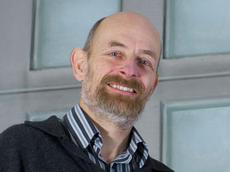How graphene behaves on a small scale
ETH Zurich is involved in the “Graphene Flagship” project through Klaus Ensslin, a professor of experimental physics. ETH Life spoke to him about the advantages of graphene and his personal vision of this very special material.

Professor Ensslin, the European Commission has chosen
graphene research for one its two flagship projects. What makes the material so
special as to have a major research project devoted to it?
Graphene is
unique. It is a thin material, a sort of film, and consists of a single atomic
layer of carbon. It is the most conductive material known today. At the same
time, it’s transparent, harder than diamond and combines seemingly
contradictory properties such as maximum elasticity and maximum tensile
strength. What’s more, it is relatively cheap to make. Graphene is regarded as
a miraculous material with enormous potential for science and applications.
What might these applications be?
Already
this year or next, there’ll be Smartphones on the market with touchscreens
based on graphene instead of indium tin oxide. Indium is toxic and stocks soon
dwindle. Graphene can be used as a touchscreen because it’s both conductive and
transparent. This application is already at a very advanced stage of
development. Other possible future applications might be conducting strips on
computer chips and graphene as a material for batteries and solar cells or a
lightweight material for aircraft. The list of potential applications is long
and goes beyond engineering into biology. With the flagship project, the EU is
ultimately trying to give the European economy a leading role in the
implementation of graphene technologies.
Where is there a need for research?
It is not
only industrial research and materials science that concentrate on graphene
these days; it is also about developing physical foundations or new synthesis
methods, tackling environmental and health aspects or finding new applications
for electronics. The flagship project has got eleven sub-projects that cover
all this.
The “leading house” for the flagship project is
the Swedish university Chalmers. They’ll be celebrating this evening, I take it.
You are also involved in the project. How pleased are you?
Naturally, I’m
delighted, too, no question. We have already “raised our glasses virtually” with
a number of European colleagues via email.
What will your part in the project be?
Our team is
involved in the subproject concerned with physical foundations. We’re
interested in how the material behaves on a small scale, at the nano-level and taking
quantum physics into account, which comes into play on this scale. The aim of
our research is ultimately to develop novel systems with graphene – so-called
quantum systems – that have unprecedented properties. Where the journey will
take us and what concrete applications will result from this research remains
to be seen. We conduct basic research. Our primary concern is to understand the
physical and quantum physical properties of these quantum systems.
Can you give us an example?
We want to
produce little islands of graphene on different substrates, for instance. Graphene
has got a honeycomb structure, whereby the edges are relevant. We’re going to
try to manipulate the edges in a targeted fashion and then study the electronic
effects that are caused by these edges. This requires extremely sensitive
measuring techniques, which we have developed in our group.
When will the flagship project get underway?
A lot is
still unclear. Before the money from the EU reaches the individual research
groups, the criteria for distributing the money among the project partners
still need to be worked out, for instance. As far as I know, these criteria
haven’t been finalised yet.
How will you use the money once it becomes
available?
As with
most research projects, the majority of the funding will go on personnel costs.
In concrete terms, we will be able to boost our existing graphene team at ETH
Zurich with some extra manpower.
And when can the first results of the project
be expected?
That
depends what you mean by results. The graphene community is already incredibly
active. In recent years, the number of results and scientific publications in
the field has skyrocketed.
What is your personal dream when you think
about the future of graphene research?
Our goal is
to develop a graphene quantum dot that contains an electron with a spin that
remains stable for a long time. A quantum dot is an artificially constructed
system that essentially behaves like an atom. It could be the unit for a future
quantum computer. There are theoretical predictions that spins in carbon-based
structures might be considerably more stable than in most semiconductor
environments.
About the person
Klaus
Ensslin (52) is a professor of experimental
physics at ETH Zurich. He conducts research at the interface between quantum
and classical physics, working on the development of new materials and their
optimisation, especially their purity. Quantum structures are structures that behave
in a similar way to individual atoms, photons or ions.
Ensslin is
also the Director of the National Centre of Competence in Research “Quantum
Science and Technology”. In a sub-project of
this research association, several groups from ETH Zurich and the universities
of Basel and Geneva are working on graphene-based quantum structures.







READER COMMENTS